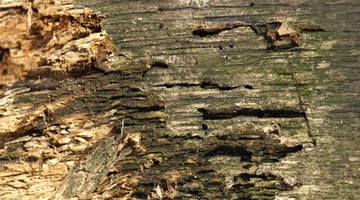Termite Damage vs. Wood Rot
Table of Contents
Termite damage and a specific type of wood rot, known as dry rot, can not only be confused, but both can cause extensive damage to structures. The two forms of damage look similar to one another and might not be noticed right away.

Being able to differentiate between the two is important for treating the potentially disastrous problems.
Dry Rot
Dry rot is a form of wood rot in which the wood is weakened by an infestation of certain types of fungi. These fungi consume the components of the wood that make it strong and stiff. Because the fungus has an interesting ability to move water from wet areas to dry, it can develop in fairly dry wood.
Subterranean Termites
Damage left by subterranean termites and the fungi that create dry rot can be confused. However, subterranean termites are small insects that live in colonies beneath the soil, only surfacing to eat and dig tunnels. They are efficient and highly destructive, consuming the wood from the inside out by feeding on the cellulose in it.
Appearance of Damage
Dry rot often resembles dry bricks or blocks because of the way in which the fungi consume the wood and transport water. These activities create channels in the wood. Subterranean termites also create channels, but in different ways. They dig shelter tubes, also known as mud tubes, from soil particles, water, saliva and fecal matter to transport termites from the soil to the wood in search of food. Channels may be branched out like a tree, with a main "trunk" leading to the ground. The two types of damage can be differentiated, however, by the detection of live termites and/or termite channels and galleries. Termites also usually pick wetter wood.
How They Got There
Dry rot caused by fungi and termite damage can occur due to a common reason: contact with the soil. This can happen with foundation cracks, in particular. Ironically, dry rot is usually caused by wood having too much contact with moisture; it's the fungi that transport the water to drier spots, making the wood "dry rot." Because subterranean termites live below the surface, foundational cracks give them an opportunity to find a fresh, readily available food source in wooden structural supports.
Treatment Options
Mild cases of dry rot can be controlled by eliminating moisture sources, such as leaky pipes or leaks in basement foundations. If the dry rot is more extensive, the wood is treated. Commonly this is done with boric acid, or borate, which can also prevent insect damage.
Subterranean termite damage is treated with termiticides, or insecticides that target termites, applied to the soil, along with termite baits. Before the 1980s, these insecticides were highly toxic, but as of 2010, lower toxicity organophosphates and pyrethroid insecticides are available.
The Drip Cap
- Termite damage and a specific type of wood rot, known as dry rot, can not only be confused, but both can cause extensive damage to structures.
- However, subterranean termites are small insects that live in colonies beneath the soil, only surfacing to eat and dig tunnels.
- Dry rot often resembles dry bricks or blocks because of the way in which the fungi consume the wood and transport water.
- These activities create channels in the wood.
- The two types of damage can be differentiated, however, by the detection of live termites and/or termite channels and galleries.
- This can happen with foundation cracks, in particular.
References
Writer Bio
Elizabeth Jennings began publishing creative works in 1988 and has been a professional editor and writer since 2002. She holds a dual Bachelor of Arts in anthropology and philosophy.
Photo Credits
- old texture image by vojvodic from Fotolia.com
- old texture image by vojvodic from Fotolia.com
More Articles



